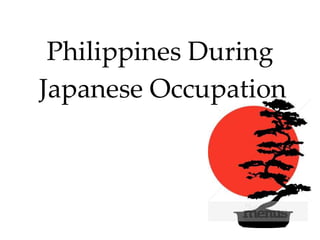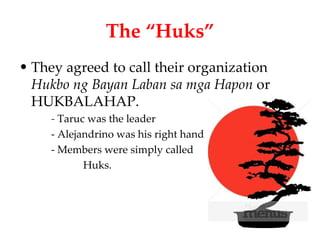Philippines during japanese occupation (revised)
- 1. Philippines During Japanese Occupation
- 2. During World War II 1941 (Dec. 8) ¨C Japan invaded the Philippines - Pampanga -Nichols Field -Lingayen Gulf -Manila
- 3. During World War II 1941 (Dec. 25) Gen.?Douglas MacArthur?declared Manila an open city. ( on the advice of commonwealth President Manuel L. Quezon to avoid its destruction)
- 4. During World War II 1942 (Jan. 2) ¨CJapanese occupied Manila. 1942 (April 9) ¨C US and Filipino defendants in Bataan surrendered to the Japanese
- 5. During World War II MacArthur escaped to Corregidor 76,000 captured soldiers were forced to embark on the "Death March" to a prison camp more than 100 kilometers north. ~10,000 prisoners died due to thirst, hunger and exhaustion.
- 6. The ¡°Huks¡± farmers of Pampanga banded together and created local brigades for their protection -Luis Taruc -Juan Feleo -Castro Alejandrino agreed to fight the Japanese as a unified guerilla army
- 7. The ¡°Huks¡± They agreed to call their organization Hukbo ng Bayan Laban sa mga Hapon or HUKBALAHAP. - Taruc was the leader - Alejandrino was his right hand - Members were simply called Huks.
- 8. The Philippine Executive Commission Established on January 23, 1942
- 9. The Philippine Executive Comission Chairperson: Jorge Vargas Dept. heads: Interior: Benigno Aquino Sr. Finance: Antonio delas Alas Justice: Jose P. Laurel Education, Health & Public Welfare: Claro M. Recto Public Works & Communication: Quintin Paredes Chief Justice of the Supreme Court: Jose Yulo
- 10. The Philippine Executive Comission new constitution -noticeably lacked a bill of rights -contained 12 articles lifted from the 1935 constitution that fitted the wishes of the Japanese -was meant to be in effect only temporarily, while the Philippines still in chaos
- 12. The Second Republic September 20 1943 - the?KALIBAPI held a party convention - to elect 54 members of the National Assembly (assembly was actually made of 108 members but half of this number was composed of incumbent governors and city mayors) - President: Jose P. Laurel - Vice President: Benigno Aquino Sr. Ramon Anancena
- 13. The Second Republic Inauguration -October 14 1943 -on the front steps of the legislative building in Manila -Philippine flag was hoisted as the national anthem was played
- 14. The Second Republic Meanwhile¡ -Japanese started using propaganda to gain the trust and confidence of?Filipinos?who refused to cooperate with them -hung giant posters and distribute their materials that contains such slogans as "the Philippines belong to the Filipinos." -also used newspapers, movies, and others to publicize the same idea Promoting Japanese propaganda was one of the main objectives of the? KALIBAPI , but still Japanese failed to gain the trust of the Filipinos.
- 16. Gen. MacArthur Returns October 20, 1944 Leyte General Douglas MacArthur said: "I have Returned."
- 17. Gen. MacArthur Returns Oct. 23 - 26, 1944 -Americans engaged Japanese forces in the Battle of Leyte Gulf -almost destroyed the entire Japanese fleet -said to have signaled the beginning of Philippine liberation from the Japanese
- 18. Gen. MacArthur Returns mid-December -American soldiers had reached Mindoro -Japanese secured other area January 9, 1945 US liberation forces successfully docked at Lingayen Gulf Lt. Gen.Tomoyuki Yamashita, supreme commander of the Japanese troops in Manila, mobilize his kamikazes but they failed to stop Americans
- 19. Gen. MacArthur Returns December 8, 1944 President Laurel and his cabinet moved to Baguio upon orders of Yamashita Japanese forces retreated to Yamashita line a jungle battlefront stretching along the Sierra Madre Mountains from Antipolo, Rizal to Appari Cagayan.
- 20. Gen. MacArthur Returns it took 3 weeks of intense fighting before Japanese finally surrendered on February 23,1945 Gen. MacArthur continued to liberate other parts of the country proclaim general freedom from the Japanese on July 4, 1945.?
- 21. sources http://www.philippine-history.org/japanese-occupation.htm http://www.mtholyoke.edu/~aefrazie/world%20politics116/history_occupation/japanese/japanese_occupation.htm




















